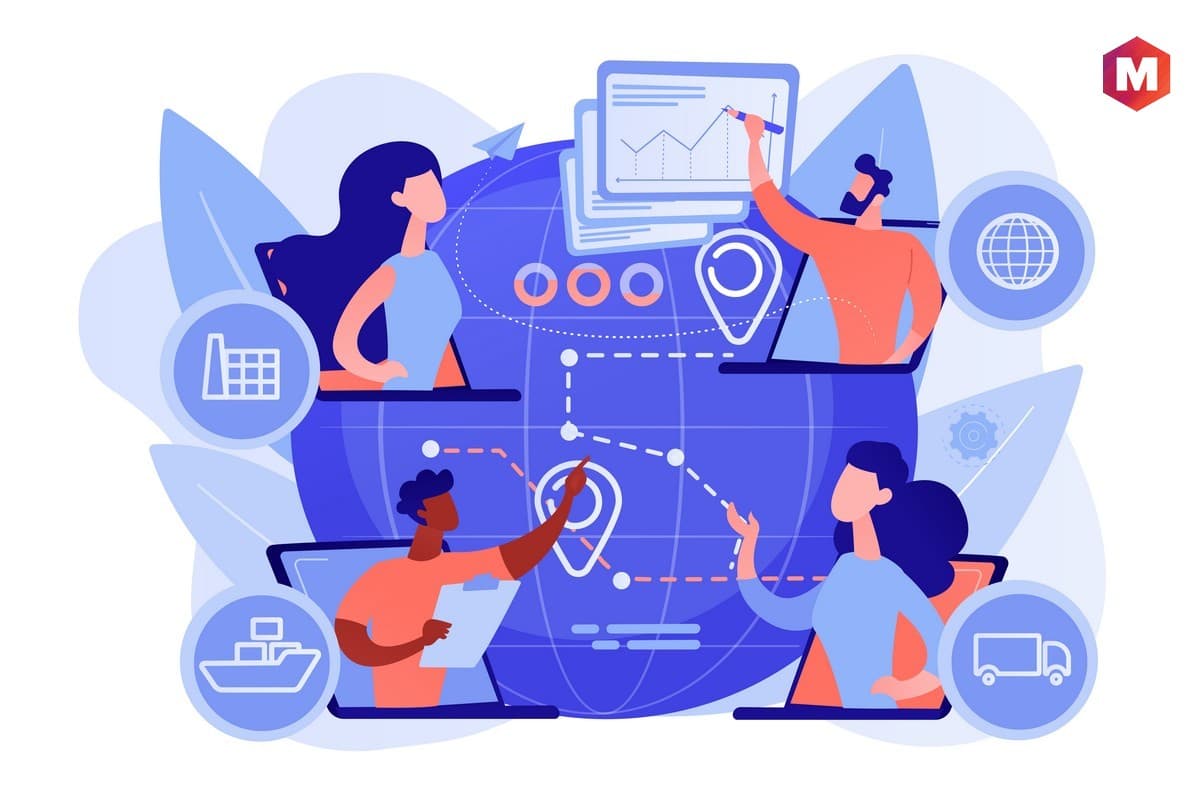Commerce is the exchange of goods, services, or something of value, between businesses or entities. Commerce is often seen as one of the fundamental pillars of modern society. In fact, commerce is so important that it has been said that “commerce is the lifeblood of civilization.” Commerce has been a key driver of economic growth and prosperity throughout history.
For example, the rise of the ancient civilizations of Mesopotamia and Egypt was partly due to their early development of trade and commerce. Commerce has also played a significant role in the growth of the modern world economy. Commerce is not just about the exchange of goods and services – it also includes other activities such as marketing, finance, and logistics. Commerce is a dynamic and ever-changing field, and businesses must constantly adapt to changes in the marketplace in order to stay competitive.
Table of Contents
What is Commerce?
Definition: Commerce is the process of exchanging goods or services including some monetary aspects along with the logistical process of transforming raw materials into usable goods or services. Although the term is commonly used to refer to trade between businesses or entities, it can also refer to trade between individuals.
In other words, if a company sends inventory from one state to another and the distance is large enough such that logistics and transportation of these goods or services across various jurisdictions are required, then commerce in the real sense has occurred. To enable trade and industry to function properly, trade and industry must occur together in a harmonious manner.
Understanding Commerce
The Commerce Clause of the United States Constitution gives Congress the power “to regulate Commerce with foreign Nations, and among the several States, and with the Indian Tribes.” This clause provides Congress with a broad mandate to enact legislation that affects interstate and international commerce.
Commerce is essential to the functioning of modern societies. It enables businesses to produce goods and services that are then exchanged in marketplaces around the world. Commerce also allows for the efficient allocation of resources and facilitates the exchange of information and ideas.
From the early days of bartering to today’s globalized economy, commerce has always been a key driver of human progress. Commerce has helped to create wealth and lift people out of poverty. It has also been a source of conflict and tension, as different groups have competed for control of trade routes and resources.
Nowadays, commerce normally refers to the macroeconomic study of the market system and its behavior. The term can also be used to refer to specific transactions or exchanges between businesses, as well as the study of the economic behavior of individuals, businesses, and governments.
A company’s primary emphasis is on distribution rather than production, which makes commerce a subset of business. The purchase or sale of a single item is referred to as a transaction, whereas the entire economy’s transactions involving that item are referred to as commerce.
Commerce is important to our society in the following ways:
- It drives economic growth
- It creates jobs
- It improves living standards
- It generates tax revenue
- It promotes exports and imports
Where did the word commerce come from?
It originates from the Latin commercium which means “to trade together.”
Commercium incorporates the prefix com- which means “together” and merc?r? which means “to buy or deal.”
This way, commerce revolves around the process of buying and selling merchandise and many other items.
Elements of Commerce
1. Trade
Commerce is often used interchangeably with trade, and the two terms are indeed closely related. Trade refers to the process of exchanging goods or services between two or more parties. Commerce also includes the process of producing and distributing goods or services, as well as the process of exchanging money for goods or services.
2. Finance
Commerce also encompasses the activity of finance, which is the process of channeling funds from one party to another. Finance includes the issuance and trading of financial instruments, as well as the management of financial assets.
3. Marketing
Commerce also includes marketing, which is the process of creating and delivering messages that promote the interests of a business. Marketing activities can include advertising, public relations, and market research.
4. Retail
Commerce also includes retail, which is the process of selling goods or services to customers. Retail businesses can be either brick-and-mortar establishments or online stores.
5. E-commerce
Commerce also includes e-commerce, which is the process of buying and selling goods or services online. E-commerce businesses can be either B2C (business-to-consumer) or B2B (business-to-business).
Implementation and Management of Commerce
Commercial activity may rapidly improve the standard of living in a country and enhance its reputation in the world if properly managed.
The management of commerce generally refers to the administration of trade and industry. It includes the regulation of businesses, the promotion of exports, and the protection of consumers.
The management of commerce also encompasses the development and implementation of trade policies. Trade policies are designed to promote the interests of a country’s businesses and industries. They can be either protectionist or free trade in nature.
Protectionist trade policies seek to limit imports by imposing tariffs or quotas on imported goods. Free trade policies, on the other hand, seek to remove barriers to trade and allow businesses to operate freely in the global marketplace.
The management of commerce also includes the development and implementation of industrial policies. Industrial policies are designed to promote the growth of a country’s manufacturing sector. They can be either protectionist or free market in nature.
Protectionist industrial policies seek to limit foreign competition by imposing tariffs or quotas on imported goods. Free market industrial policies, on the other hand, seek to remove barriers to trade and allow businesses to operate freely in the global marketplace.
The management of commerce also includes the development and implementation of economic policies. Economic policies are designed to promote the overall growth and welfare of a country’s economy. They can be either Keynesian or monetarist in nature.
Keynesian economic policies seek to promote economic growth through government spending. Monetarist economic policies, on the other hand, seek to promote economic growth through monetary policy.
The management of commerce also includes the development and implementation of fiscal policies. Fiscal policies are designed to promote the efficient use of resources within a country’s economy. They can be either tax-based or expenditure-based.
Tax-based fiscal policies seek to raise revenue through taxation. Expenditure-based fiscal policies, on the other hand, seek to reduce government spending.
The management of commerce also includes the development and implementation of monetary policies. Monetary policies are designed to promote the stability of a country’s currency. They can be either expansionary or contractionary.
Expansionary monetary policies seek to increase the money supply. Contractionary monetary policies, on the other hand, seek to reduce the money supply.
The management of commerce also includes the development and implementation of trade policies. Trade policies are designed to promote the interests of a country’s businesses and industries. They can be either protectionist or free trade in nature.
Commerce Business Models
1. Business-to-Consumer (B2C)
A business-to-consumer, or B2C, model refers to the sale of goods or services by a business directly to a consumer.
2. Business-to-Business (B2B)
A business-to-business, or B2B, model refers to the sale of goods or services by one business to another.
3. Commerce as a Platform (CaaP)
Commerce as a platform, or CaaP, model refers to a business that uses its commerce capabilities to power other businesses.
4. Commerce as a Service (CaaS)
The commerce as a service, or CaaS, model refers to a business that provides commerce-related services to other businesses.
5. Commerce in the Cloud (CIC)
Commerce in the cloud, or CiC, model refers to a business that uses cloud-based technologies to power its commerce operations.
6. Mobile Commerce (M-Commerce)
A mobile commerce, or m-commerce, model refers to the sale of goods or services using mobile devices.
7. Social Commerce (S-Commerce)
The social commerce, or s-commerce, model refers to the sale of goods or services using social media platforms.
8. B2A: Business-to-Administration
Commerce between a company and public administrations or other government bodies.
9. C2B Commerce
Commerce in which the final consumer is also involved in the production or development of the product or service purchased.
10. C2C Commerce
Commerce between two consumers. The best-known examples are online auction platforms such as eBay.
11. D2C Commerce
Commerce in which the producer sells its products directly to the consumer, without going through intermediaries.
12. E-commerce
Commerce is carried out electronically, normally over the Internet. From small businesses to large-scale businesses to future-driven business models, all use commerce.
13. Intellectual commerce
Intellectual commerce refers to the exchange of ideas, knowledge, or information. This type of commerce is often seen as the foundation of economic growth and development.
14. Interstate commerce
Commerce takes place between two or more states within a country.
15. Intrastate Commerce
Commerce takes place within the confines of a single state.
16. Local commerce
Commerce takes place on a local level, such as between businesses and consumers in the same city or town.
The Rise of E-Commerce
E-commerce is the buying and selling of goods and services over the Internet. It has been growing at an incredible rate since the early 1990 s. In 2018, global e-commerce sales reached $2.8 trillion. That figure is expected to grow to $4.8 trillion by 2021.
- There are several reasons for the tremendous growth of e-commerce. The first is the increasing number of people who have access to the Internet. In 1995, there were only 16 million Internet users worldwide. By 2018, that number had grown to 3.4 billion.
- Another reason for the growth of e-commerce is the increasing use of mobile devices. In 2018, 52.2 percent of all e-commerce traffic was generated through mobile devices. That figure is expected to increase to 72.9 percent by 2021.
- The third reason for the growth of e-commerce is the increasing use of social media. In 2018, social media accounted for 18 percent of all Internet traffic. That figure is expected to grow to 25 percent by 2021.
- The fourth reason for the growth of e-commerce is the increasing trust in online transactions. In 2018, 64 percent of Internet users said they were confident in making online purchases. That figure is expected to grow to 80 percent by 2021.
- The fifth reason for the growth of e-commerce is the increasing availability of payment options. In 2018, there were more than 2.5 billion credit and debit cardholders worldwide. That figure is expected to grow to 3.1 billion by 2021.
- The sixth reason for the growth of e-commerce is the increasing number of retailers that are selling online. In 2018, there were more than 24 million online retailers worldwide. That figure is expected to grow to 28 million by 2021.
- The seventh and final reason for the growth of e-commerce is the increasing number of cross-border transactions. In 2018, 34 percent of all e-commerce sales were cross-border transactions. That figure is expected to grow to 50 percent by 2021.
Conclusion!
In the end, Commerce is the activity of buying and selling goods and services. E-commerce is commerce that is carried out electronically, over the internet. And M-commerce is Commerce conducted using mobile devices. The Commerce industry has seen tremendous growth in recent years and this trend is expected to continue in the coming years.
If you’re thinking about starting an online business, then you should definitely consider e-commerce. And if you’re already selling online, then you should think about adding m-commerce to your business model.
Do you have any thoughts or experiences with Commerce? Let us know in the comments below!
Liked this post? Check out the complete series on Business

